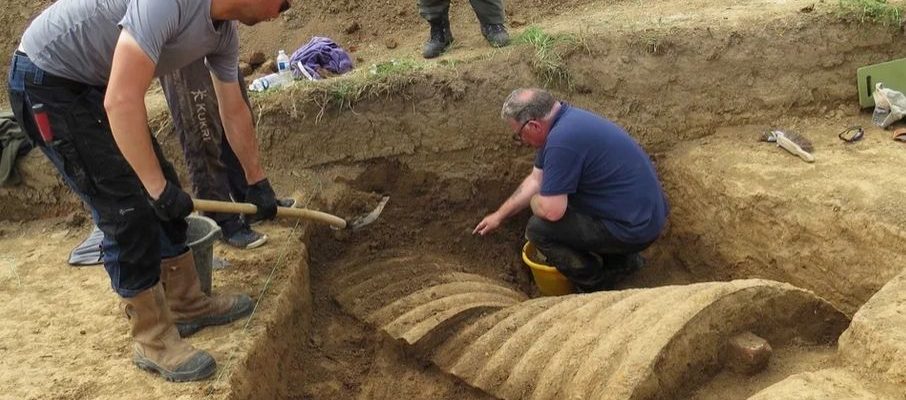In search of missing soldiers. Occasionally archeology days which take place on Saturday and Sunday, the museum of the battle of Fromelles, in the North, offers to become an archaeologist for a day. Here, it is neither prehistory nor antiquity that is highlighted, but a more recent period: the First World War. Indeed, it is in this commune of Flanders that took place, in 2008, one of the largest excavations on a site of the War 14-18.
Mass graves had been discovered and 250 bodies of soldiers had been unearthed, identified for the most part and reburied, nearly a century after their death, in a new military cemetery. Since this episode, the authorities are increasingly concerned about the fate of these soldiers who disappeared and were found during major works. A better organization of services now makes it possible to deal more effectively with their remains.
A hundred soldiers being identified
Last week, for example, three Canadian soldiers from the Great War were laid to rest with great fanfare in northern France. Reported missing at the front 105 years ago, they were found in 2017 near Lens, in Pas-de-Calais, during the construction of the new hospital. A hundred other soldiers, who came out of the ground at the same place, are being identified in the laboratories of the Commonwealth War Graves Commission (CWGC), an organization monitoring the graves of soldiers from the former British Empire.
And corpses, we risk discovering many more in the coming years. At least 600,000 men who died at the front in northern France during the First World War are still missing, buried without burial. For a long time, the bones regularly found between Belgium and Paris were discreetly evacuated.
But the CWGC has been staffed for two years with anthropologists based in the north of France. They are responsible for recovering the bodies and any identifying elements. On the French side, an anthropologist was also recently recruited by the National Office for Veterans.
“We have built a network in the world of construction, mine clearance and the police to be notified of fortuitous discoveries”, underlines Stephan Naji, head of the CWGC recovery unit. This service takes care of 40 to 60 bodies each year, discovered during agricultural work or construction sites, such as wind turbines.
As in the series The experts
“We will do our best to identify as many of them as possible, and to find their families. It’s a brief but crucial occasion,” said CWGC Director Claire Horton. Because if the passage of time makes the task more complex than in the television series The expertssome of the remains found can be identified, in particular by DNA testing.
These analyzes remain rare for French fighters, but certain countries such as Great Britain, Canada or Australia do not hesitate to sometimes embark on genealogical research to identify descendants, explains the CWGC.
Such identification takes several years. But if successful, it leads to a military ceremony in the nearest Commonwealth cemetery, to which the descendants are invited. When it is impossible to release him from anonymity, the soldier is reburied with honors, under a stele engraved with the epitaph “known only to God”.
Other more traditional methods of identification are still in force. Uniform buttons, epaulette badges and regimental badges are the first clues, as well as canteens or whistles bearing the name of the military unit. But everything must be matched: some soldiers exchanged their badges as a sign of camaraderie, or collected equipment from brothers in arms, such as Australian boots, deemed to be of good quality.
Uncover clues to find the identity
Personal items – razors, forks, watches, etc. – are carefully cleaned to identify possible clues: industrial hallmark indicating the date or place of manufacture, engraved initials, etc. If the country of origin is confirmed, the information is transmitted to the authorities of this country, who then go through their list of missing persons to compare the data.
Dozens, even hundreds of other soldiers could thus be exhumed during the digging of the Seine-Nord canal which will join Compiègne, in the Oise, to Cambrai in the North, running for 107 km, including a hundred along from the front line. So much so that a new cemetery with 1,200 places is being built in Loos-en-Gohelle, adjoining the current British cemetery.
As for Germany, the country also now seems to be taking a close interest in its soldiers who disappeared from the First World War. On the other hand, the German organization, the VDK (Volksbund Deutsche Kriegsgräberfürsorge), comes up against a major obstacle for identification.
“During the Great War, the instruction was to remove the license plates of deceased soldiers when possible,” says a German historian who prefers to remain anonymous. This is why it is sometimes difficult to identify the bodies. Nevertheless, the VDK, with the support of the CWGC, could participate, in the coming months, in specific archaeological research in the Pas-de-Calais.
A site abandoned due to mobilization
Still, the subject is still sensitive. In 2017, an article by 20 minutes caused outrage in Australia. Wind turbines were to be built on an Australian memory site, near Arras, in Pas-de-Calais. Faced with mobilization from the other side of the world, the project was finally abandoned by Engie.
In this sector, nearly 2,500 bodies have already been found since the end of the 14-18 war. However, there are still between 3,000 and 4,000 buried under the 4 km2 of the battlefield. And we suspect the presence of several mass graves, like those discovered in Fromelles, in the North, in 2008.
In addition to desecrating a memorial site, there was a great risk of falling on the bodies of soldiers during the construction site. The proof, two years later, in 2019, on this same former battlefield, excavations carried out by a team of British archaeologists to find a tank had directly fallen on three bodies of German soldiers.

